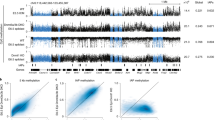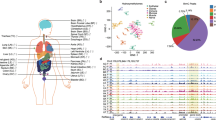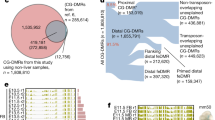Abstract
Transposable element (TE)-derived sequences comprise half of the human genome and DNA methylome and are presumed to be densely methylated and inactive. Examination of genome-wide DNA methylation status within 928 TE subfamilies in human embryonic and adult tissues identified unexpected tissue-specific and subfamily-specific hypomethylation signatures. Genes proximal to tissue-specific hypomethylated TE sequences were enriched for functions important for the relevant tissue type, and their expression correlated strongly with hypomethylation within the TEs. When hypomethylated, these TE sequences gained tissue-specific enhancer marks, including monomethylation of histone H3 at lysine 4 (H3K4me1) and occupancy by p300, and a majority exhibited enhancer activity in reporter gene assays. Many such TEs also harbored binding sites for transcription factors that are important for tissue-specific functions and showed evidence of evolutionary selection. These data suggest that sequences derived from TEs may be responsible for wiring tissue type–specific regulatory networks and may have acquired tissue-specific epigenetic regulation.
This is a preview of subscription content, access via your institution
Access options
Subscribe to this journal
Receive 12 print issues and online access
$209.00 per year
only $17.42 per issue
Buy this article
- Purchase on Springer Link
- Instant access to full article PDF
Prices may be subject to local taxes which are calculated during checkout




Similar content being viewed by others
References
Lander, E.S. et al. Initial sequencing and analysis of the human genome. Nature 409, 860–921 (2001).
Bourque, G. et al. Evolution of the mammalian transcription factor binding repertoire via transposable elements. Genome Res. 18, 1752–1762 (2008).
Fichte, C. Transposable elements and the evolution of regulatory networks. Nat. Rev. Genet. 9, 397–405 (2008).
Kunarso, G. et al. Transposable elements have rewired the core regulatory network of human embryonic stem cells. Nat. Genet. 42, 631–634 (2010).
Lynch, V.J., Leclerc, R.D., May, G. & Wagner, G.P. Transposon-mediated rewiring of gene regulatory networks contributed to the evolution of pregnancy in mammals. Nat. Genet. 43, 1154–1159 (2011).
Wang, T. et al. Species-specific endogenous retroviruses shape the transcriptional network of the human tumor suppressor protein p53. Proc. Natl. Acad. Sci. USA 104, 18613–18618 (2007).
Xie, D. et al. Rewirable gene regulatory networks in the preimplantation embryonic development of three mammalian species. Genome Res. 20, 804–815 (2010).
McClintock, B. Controlling elements and the gene. Cold Spring Harb. Symp. Quant. Biol. 21, 197–216 (1956).
McClintock, B. The origin and behavior of mutable loci in maize. Proc. Natl. Acad. Sci. USA 36, 344–355 (1950).
Jordan, I.K., Rogozin, I.B., Glazko, G.V. & Koonin, E.V. Origin of a substantial fraction of human regulatory sequences from transposable elements. Trends Genet. 19, 68–72 (2003).
Polavarapu, N., Marino-Ramirez, L., Landsman, D., McDonald, J.F. & Jordan, I.K. Evolutionary rates and patterns for human transcription factor binding sites derived from repetitive DNA. BMC Genomics 9, 226 (2008).
Morgan, H.D., Sutherland, H.G., Martin, D.I. & Whitelaw, E. Epigenetic inheritance at the agouti locus in the mouse. Nat. Genet. 23, 314–318 (1999).
Slotkin, R.K. & Martienssen, R. Transposable elements and the epigenetic regulation of the genome. Nat. Rev. Genet. 8, 272–285 (2007).
Bird, A. DNA methylation patterns and epigenetic memory. Genes Dev. 16, 6–21 (2002).
Harris, R.A. et al. Comparison of sequencing-based methods to profile DNA methylation and identification of monoallelic epigenetic modifications. Nat. Biotechnol. 28, 1097–1105 (2010).
Maunakea, A.K. et al. Conserved role of intragenic DNA methylation in regulating alternative promoters. Nature 466, 253–257 (2010).
Day, D.S., Luquette, L.J., Park, P.J. & Kharchenko, P.V. Estimating enrichment of repetitive elements from high-throughput sequence data. Genome Biol. 11, R69 (2010).
Chung, D. et al. Discovering transcription factor binding sites in highly repetitive regions of genomes with multi-read analysis of ChIP-Seq data. PLoS Comput. Biol. 7, e1002111 (2011).
Wang, J., Huda, A., Lunyak, V.V. & Jordan, I.K. A Gibbs sampling strategy applied to the mapping of ambiguous short-sequence tags. Bioinformatics 26, 2501–2508 (2010).
Schmid, C.D. & Bucher, P. MER41 repeat sequences contain inducible STAT1 binding sites. PLoS ONE 5, e11425 (2010).
Samuelson, L.C., Wiebauer, K., Snow, C.M. & Meisler, M.H. Retroviral and pseudogene insertion sites reveal the lineage of human salivary and pancreatic amylase genes from a single gene during primate evolution. Mol. Cell. Biol. 10, 2513–2520 (1990).
Medstrand, P., Landry, J.R. & Mager, D.L. Long terminal repeats are used as alternative promoters for the endothelin B receptor and apolipoprotein C-I genes in humans. J. Biol. Chem. 276, 1896–1903 (2001).
Dunn, C.A., Medstrand, P. & Mager, D.L. An endogenous retroviral long terminal repeat is the dominant promoter for human β1,3-galactosyltransferase 5 in the colon. Proc. Natl. Acad. Sci. USA 100, 12841–12846 (2003).
Cohen, C.J., Lock, W.M. & Mager, D.L. Endogenous retroviral LTRs as promoters for human genes: a critical assessment. Gene 448, 105–114 (2009).
Yan, Z. & Banerjee, R. Redox remodeling as an immunoregulatory strategy. Biochemistry 49, 1059–1066 (2010).
Angelini, G. et al. Antigen-presenting dendritic cells provide the reducing extracellular microenvironment required for T lymphocyte activation. Proc. Natl. Acad. Sci. USA 99, 1491–1496 (2002).
Stadler, M.B. et al. DNA-binding factors shape the mouse methylome at distal regulatory regions. Nature 480, 490–495 (2011).
Birney, E. et al. Identification and analysis of functional elements in 1% of the human genome by the ENCODE pilot project. Nature 447, 799–816 (2007).
Roussa, E., von Bohlen und Halbach, O. & Krieglstein, K. TGF-β in dopamine neuron development, maintenance and neuroprotection. Adv. Exp. Med. Biol. 651, 81–90 (2009).
Britsch, S. et al. The transcription factor Sox10 is a key regulator of peripheral glial development. Genes Dev. 15, 66–78 (2001).
Wegner, M. & Stolt, C.C. From stem cells to neurons and glia: a Soxist's view of neural development. Trends Neurosci. 28, 583–588 (2005).
Dunham, I. et al. An integrated encyclopedia of DNA elements in the human genome. Nature 489, 57–74 (2012).
Rosenbloom, K.R. et al. ENCODE whole-genome data in the UCSC Genome Browser: update 2012. Nucleic Acids Res. 40, D912–D917 (2012).
Doolittle, W.F. & Sapienza, C. Selfish genes, the phenotype paradigm and genome evolution. Nature 284, 601–603 (1980).
Orgel, L.E. & Crick, F.H. Selfish DNA: the ultimate parasite. Nature 284, 604–607 (1980).
Ostertag, E.M. & Kazazian, H.H. Jr. Biology of mammalian L1 retrotransposons. Annu. Rev. Genet. 35, 501–538 (2001).
Martínez-Garay, I. et al. Intronic L1 insertion and F268S, novel mutations in RPS6KA3 (RSK2) causing Coffin-Lowry syndrome. Clin. Genet. 64, 491–496 (2003).
Claverie-Martin, F., Gonzalez-Acosta, H., Flores, C., Anton-Gamero, M. & Garcia-Nieto, V. De novo insertion of an Alu sequence in the coding region of the CLCN5 gene results in Dent's disease. Hum. Genet. 113, 480–485 (2003).
Fazzari, M.J. & Greally, J.M. Epigenomics: beyond CpG islands. Nat. Rev. Genet. 5, 446–455 (2004).
Kidwell, M.G. & Lisch, D. Transposable elements as sources of variation in animals and plants. Proc. Natl. Acad. Sci. USA 94, 7704–7711 (1997).
Batzer, M.A. & Deininger, P.L. Alu repeats and human genomic diversity. Nat. Rev. Genet. 3, 370–379 (2002).
Brosius, J. Retroposons—seeds of evolution. Science 251, 753 (1991).
Britten, R.J. Cases of ancient mobile element DNA insertions that now affect gene regulation. Mol. Phylogenet. Evol. 5, 13–17 (1996).
Miller, W.J., McDonald, J.F., Nouaud, D. & Anxolabehere, D. Molecular domestication—more than a sporadic episode in evolution. Genetica 107, 197–207 (1999).
van de Lagemaat, L.N., Landry, J.R., Mager, D.L. & Medstrand, P. Transposable elements in mammals promote regulatory variation and diversification of genes with specialized functions. Trends Genet. 19, 530–536 (2003).
Lowe, C.B., Bejerano, G. & Haussler, D. Thousands of human mobile element fragments undergo strong purifying selection near developmental genes. Proc. Natl. Acad. Sci. USA (in the press) (2007).
Lindblad-Toh, K. et al. A high-resolution map of human evolutionary constraint using 29 mammals. Nature 478, 476–482 (2011).
Schmidt, D. et al. Waves of retrotransposon expansion remodel genome organization and CTCF binding in multiple mammalian lineages. Cell 148, 335–348 (2012).
Bejerano, G. et al. A distal enhancer and an ultraconserved exon are derived from a novel retroposon. Nature 441, 87–90 (2006).
Sasaki, T. et al. Possible involvement of SINEs in mammalian-specific brain formation. Proc. Natl. Acad. Sci. USA 105, 4220–4225 (2008).
Beck, C.R. et al. LINE-1 retrotransposition activity in human genomes. Cell 141, 1159–1170 (2010).
Iskow, R.C. et al. Natural mutagenesis of human genomes by endogenous retrotransposons. Cell 141, 1253–1261 (2010).
Ward, M.C. et al. Latent regulatory potential of human-specific repetitive elements. Mol. Cell 49, 262–272 (2013).
Chuong, E.B., Rumi, M.A., Soares, M.J. & Baker, J.C. Endogenous retroviruses function as species-specific enhancer elements in the placenta. Nat. Genet. 45, 325–329 (2013).
McLean, C.Y. et al. GREAT improves functional interpretation of cis-regulatory regions. Nat. Biotechnol. 28, 495–501 (2010).
Romanov, S.R. et al. Normal human mammary epithelial cells spontaneously escape senescence and acquire genomic changes. Nature 409, 633–637 (2001).
Bernstein, B.E. et al. The NIH Roadmap Epigenomics Mapping Consortium. Nat. Biotechnol. 28, 1045–1048 (2010).
O'Geen, H., Echipare, L. & Farnham, P.J. Using ChIP-seq technology to generate high-resolution profiles of histone modifications. Methods Mol. Biol. 791, 265–286 (2011).
Grunau, C., Clark, S.J. & Rosenthal, A. Bisulfite genomic sequencing: systematic investigation of critical experimental parameters. Nucleic Acids Res. 29, E65–5 (2001).
Rohde, C., Zhang, Y., Reinhardt, R. & Jeltsch, A. BISMA—fast and accurate bisulfite sequencing data analysis of individual clones from unique and repetitive sequences. BMC Bioinformatics 11, 230 (2010).
Acknowledgements
We thank the many collaborators at the Reference Epigenome Mapping Centers (REMCs), the Epigenome Data Analysis and Coordination Center and the NCBI who have generated and processed data that were used in this project. We acknowledge the dedicated system administrators at the Washington University Center for Genome Sciences and Systems Biology who have provided an excellent computing environment. We thank the UCSC Genome Browser bioinformatics team for providing processed ENCODE data. We acknowledge support from the US National Institutes of Health (NIH) Roadmap Epigenomics Program, sponsored by the National Institute on Drug Abuse (NIDA) and the National Institute of Environmental Health Sciences (NIEHS). J.F.C., T.W., P.J.F. and M.H. are supported by US NIH grant 5U01ES017154. B.Z. and X.Z. are supported by the NIDA R25 program DA027995. K.L.L. and C.L.M. are supported by US NIH grants P01CA095616 and P01CA142536. T.W. is supported in part by the March of Dimes Foundation, the Edward Mallinckrodt Jr. Foundation, US NIH grant P50CA134254 and a generous start-up package from the Department of Genetics at the Washington University School of Medicine.
Author information
Authors and Affiliations
Contributions
J.F.C. and T.W. designed the study. C.L.M., K.L.L., P.G., M.S., T.D.T., T.K. and A.W. collected samples. C.H., H.O., P.J.F., A.J.M., A.T., B.K., S.C., R.M., M.H. and M.A.M. performed sequencing assays. M.X., B.Z., R.F.L., D.L., X.Z., H.J.L., P.A.F.M. and T.W. performed data analysis. C.H., X.X. and M.X. performed bisulfite validation and reporter gene assays. M.X., J.F.C. and T.W. wrote the manuscript. All authors discussed the results and contributed to writing the manuscript.
Corresponding authors
Ethics declarations
Competing interests
The authors declare no competing financial interests.
Supplementary information
Supplementary Text and Figures
Supplementary Note, Supplementary Figures 1–17, Supplementary Tables 1–6 (PDF 3214 kb)
Rights and permissions
About this article
Cite this article
Xie, M., Hong, C., Zhang, B. et al. DNA hypomethylation within specific transposable element families associates with tissue-specific enhancer landscape. Nat Genet 45, 836–841 (2013). https://doi.org/10.1038/ng.2649
Received:
Accepted:
Published:
Issue Date:
DOI: https://doi.org/10.1038/ng.2649
This article is cited by
-
Transposable elements mediate genetic effects altering the expression of nearby genes in colorectal cancer
Nature Communications (2024)
-
An intronic LINE-1 regulates IFNAR1 expression in human immune cells
Mobile DNA (2023)
-
Transposable element-initiated enhancer-like elements generate the subgenome-biased spike specificity of polyploid wheat
Nature Communications (2023)
-
Mammalian genome innovation through transposon domestication
Nature Cell Biology (2022)
-
Roles of transposable elements in the regulation of mammalian transcription
Nature Reviews Molecular Cell Biology (2022)



